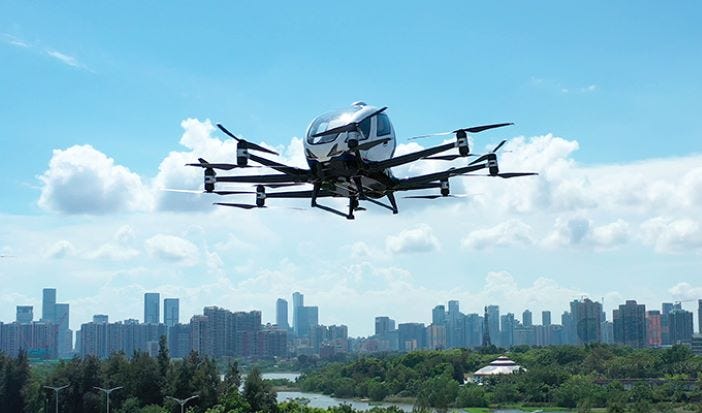Back at CES 2016, eHang wowed the world with a concept for an autonomous passenger-carrying octacopter. Seven years later, this concept has transformed into the world's first fully certified electric vertical takeoff and landing (eVTOL) air taxi, approved for commercial use, which was finally conceaded in October 2023.
The Chinese regulator formally accepted EHang’s type certification application for its passenger air taxi in 2021. Since then, the company has worked to complete a set of objectives—tailored to the aircraft’s specific features—laid out by the regulator. In February 2022, CAAC published the “special conditions” for EH216-S, providing a basis of compliance for those objectives.
This autonomous aircraft can transport two passengers up to 30 km (18.6 miles) between charges, reaching a top speed of approximately 130 km/h (81 mph).
While its specifications may seem modest compared to competitors like the Joby S4, with its 200-mile range and 200-mph speed, the eHang 216 is well-suited for short urban hops and scenic tourist flights. The recent type certification, issued by the Chinese Civil Aviation Authority, highlights China's commitment to leading in the commercial eVTOL sector. It's important to note that this certification is applicable only in China, as the US FAA and European EASA are not expected to grant eVTOL certifications until at least 2024, with 2025 or 2026 being more likely.
Additionally, the eHang 216's full autonomy may further delay certifications in these markets, where most other air taxis pursuing certification will have pilots on board. The eHang 216's description as a "passenger-carrying unmanned aerial vehicle (UAV)" adds an amusing touch to its already remarkable journey.
In some respects, the issuance of the type certificate doesn't bring about a significant shift; eHang has been conducting passenger 'demonstration flights' across China for several years, a milestone that many Western eVTOL air taxi companies, with Volocopter being a rare exception, have yet to achieve. Joby has only just celebrated its first tentative test hovers with a pilot on board.
The primary transformation lies in the fact that eHang is now authorized to charge passengers for its services, paving the way for the company to expand its commercial, manufacturing, and ride operations on a larger scale.
There's a debatable perspective on China's swift introduction of this cutting-edge technology to the market—some view it as a risky move that could jeopardize lives. However, the EH216 state that has already undergone over 40,000 test flights, meeting all regulatory safety requirements, including public demonstrations with passengers on board. Yet, there's an undeniable apprehension; in the event of a severe eHang aircraft crash, the incident might not make it to public knowledge. Given China's media landscape, where state control is prevalent, incidents deemed potentially embarrassing might remain unreported. There's even speculation that multiple eHang crashes may have occurred without public disclosure.
eVTOLs utilize distributed propulsion with substantial redundancy. In the case of a motor failure on the EH216, 15 others stand ready to compensate, ensuring the completion of the flight safely.
Considering this perspective, China's accelerated approach may appear sensible, suggesting that the rest of the world might be entangling itself unnecessarily in bureaucratic red tape. But as they say, every sub-clause of every rule in the aviation rulebook has been written in blood.
EHang will now ramp up manufacturing at its Yunfu production facility in China’s Guangdong province. However, some days ago a shortseller company, Hindenburg Research, released a detailed, 8,000-word report on EHang that provided deeper evidence for these doubts. The report detailed how much of EHang’s 1,300-plus unit order book looked to “almost entirely be vapor” and how early sales “bear all the hallmarks of fake revenue”.




